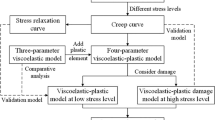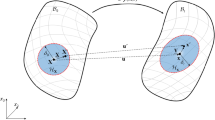Abstract
Viscoelastic materials undergo creep due to elasticity and viscosity, two intrinsic material characteristics, and a representative rheological model can be constructed for creep behavior analysis. Based on the viscoelasticity theory, this model simulates creep by formalizing elastic and viscous deformations in spring and dash-pot elements, respectively. However, most materials have internal gaps caused by the generation process, changes in the internal or external stress, etc. In this paper, a rheological model is proposed in which a gap is introduced; hence, the phenomenological behaviors are formalized using spring, dash-pot, and gap elements. The gap element has strain, but no material property. The opening or closing of the gap according to time history influences the structural changes in the model. Owing to the gap element, the energy due to external forces is dissipated before the gap is closed. After the gap is closed, it is converted and stored as internal strain energy in the spring element, which causes creep recovery. The proposed rheological model has two types, which depend on the element combination. Further, a generalized model is obtained by constructing n models on the basis of the element material properties. To validate the proposed rheological model for various stress conditions, the results predicted by three creep models (the proposed model, Burgers model, and the step-by-step method) are compared with the previously experimental results of concrete specimens because there is a large difference between the evaluations of internally stored strain energy by the creep prediction models. Analysis of a stepwise loading case and an unloading case reveal the following characteristics and mechanism of the model. When additional stress is applied, the principle of superposition is not applied to the proposed model. Instead, the model predicts creep by considering the linearity and structural change of each element. In addition, the proposed model simulates creep recovery and permanent strain more precisely compared to other creep models, which occur due to stress removal, by considering the structural change caused by the gap.






Similar content being viewed by others
References
Gatuingt F, Pijaudier-Cabot G (2002) Coupled damage and plasticity modelling in transient dynamic analysis of concrete. Int J Numer Anal Methods Geomech 26(1):1–24
Barpi F (2004) Impact behaviour of concrete: a computational approach. Eng Fract Mech 71(15):2197–2213
Jirásek M, Bažant ZP (2002) Inelastic analysis of structures. Wiley, New York
Bažant ZP, Wu ST (1973) Dirichlet series creep function for aging concrete. ASCE J Eng Mech Div 99(EM2):367–387
Bažant ZP, Wu ST (1974) Rate-type creep law of aging concrete based on Maxwell chain. Matér Constr 7(1):45–60
Emmerich H, Korn M (1987) Incorporation of attenuation into time-domain computations of seismic wave fields. Geophysics 52(9):1252–1264
Carcione JM, Kosloff D, Kosloff R (1988) Wave propagation simulation in a linear viscoacoustic medium. Geophys J Int 93(2):393–401
Carcione JM, Kosloff D, Kosloff R (1988) Wave propagation simulation in a linear viscoelastic medium. Geophys J Int 95(3):597–611
Vaishnav RN, Kesler CE (1961) Correlation of creep of concrete with its dynamic properties. T. and A.M. Report No. 603, University of Illinois, Urbana, IL 194
Hansen C (1966) Theories of multi-phase materials applied to concrete, cement mortar and cement paste. In: International conference on the structure of concrete, cement, and concrete association, London, UK pp 24–36
Chang TS, Kesler CE (1956) Correlation of sonic properties of concrete with creep and relaxation. ASTM Proc 56:1257–1272
Oloyede A, Flachsmann R, Broom ND (1992) The dramatic influence of loading velocity on the compressive response of articular cartilage. Connect Tissue Res 27(4):211–224
Reynolds T, Harris R, Chang WS (2013) Viscoelastic embedment behaviour of dowels and screws in timber under in-service vibration. Eur J Wood Wood Prod 71(5):623–634
CEB (1999) Structural concrete-textbook on behavior, design and performance. Updated knowledge of the CEB/FIP model code 1990 fib Bulletin 2(2):37–52
Gardner NJ (2004) Comparison of prediction provisions for drying shrinkage and creep of normal-strength concretes. Can J Civ Eng 31(5):767–775
Videla CC, Carreira DJ, Garner NJ (2008) Guide for modeling and calculating shrinkage and creep in hardened concrete. In: ACI, 209
Faber O (1927) Plastic yield, shrinkage and other problems of concrete and their effects on design. Min Proc 225(1928):27–73
Bažant ZP (1972) Prediction of concrete creep effects using age-adjusted effective. J Am Concrete Inst 69(4):212–217
Glanville WH (1930) Studies in reinforced concrete—III, the creep or flow of concrete under load. Building Research Technical Paper No. 12. London: Dept of Scientific and Industrial Research
Ranzi G, Gilbert RI (2010) Time-dependent behaviour of concrete structures. Spon Press, London
Park YS, Lee YH (2016) Incremental model formulation of age-dependent concrete character and its application. Eng Struct 126:328–342
Park YS, Lee YH, Lee Y (2016) Description of concrete creep under time-varying stress using parallel creep curve. Adv Mater Sci Eng Article ID 9370514, 13
Yue LL, Taerwe L (1993) Two-function method for the prediction of concrete creep under decreasing stress. Mater Struct 26(5):268–273
Mei SQ, Zhang JC, Wang YF, Zou RF (2017) Creep-recovery of normal strength and high strength concrete. Constr Build Mater 156:175–183
Gardner NJ, Tsuruta H (2004) Is superposition of creep strains valid for concretes subjected to drying creep? ACI Mater J 101(5):409–415
Acknowledgements
This research was supported by Basic Science Research Program through the National Research Foundation of Korea (NRF) funded by the Ministry of Education (2017R1A6A3A01007088).
Author information
Authors and Affiliations
Corresponding author
Ethics declarations
Conflict of interest
The author declares that he has no conflict of interest.
Rights and permissions
About this article
Cite this article
Park, YS. Rheological model incorporating gap element. Mater Struct 51, 109 (2018). https://doi.org/10.1617/s11527-018-1235-7
Received:
Accepted:
Published:
DOI: https://doi.org/10.1617/s11527-018-1235-7




